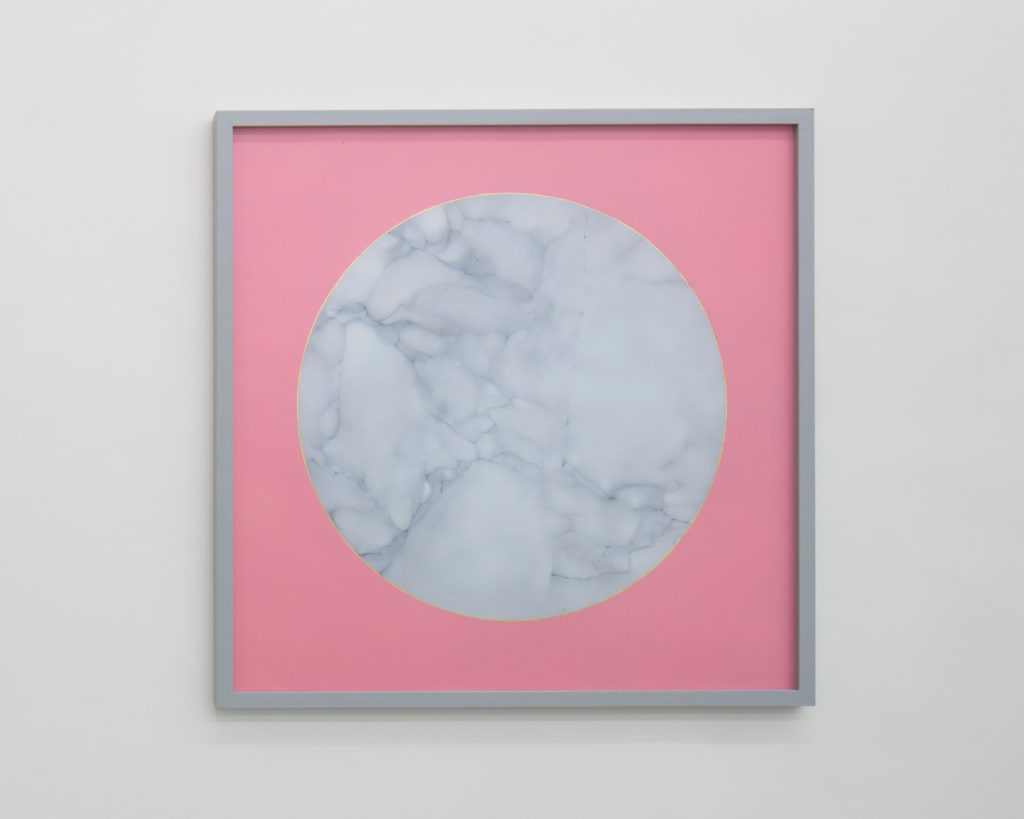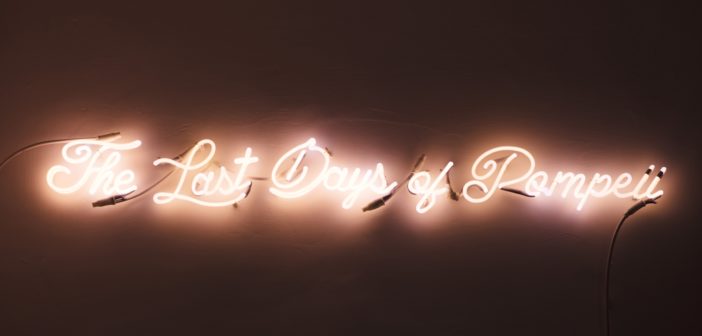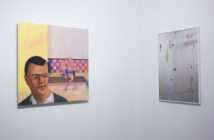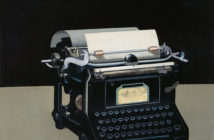“The Last Days of Pompeii” is a loaded phrase, conjuring both tragedy and opulence. Multimedia artist and musician Delia Gonzalez takes these words and burns them across a wall in a sultry pink, neon script in her solo exhibition List Projects: Delia Gonazalez, on view in the MIT List Visual Arts Center’s intimate Bakalar Gallery. With its ambivalent evocation of both welcome and warning, The Last Days of Pompeii acts as a portal to Gonzalez’s world, where ancient and modern signifiers of wealth and pleasure mingle, all within an atmosphere of clairvoyant foreboding. Gallery visitors enter the exhibition via a small, antechamber-like space awash in the glow of this sign, where they are also greeted by Vesuvius, an electronic soundtrack Gonzalez created specifically for this exhibition, which fills the space with dark, pent-up energy. Beyond the neon glow, glimpsed through an archway, is the more brightly-lit main gallery space, where a handful of large, trompe l’oeil drawings of geometric, marble-tile designs are spaced evenly along the walls. These three elements--neon sign, soundtrack, and drawings of marble--complete Gonzalez’s Pompeii.

Delia Gonzalez, Don't Exclude the Moon, 2017 Graphite, acrylic paint, gold leaf on paper, 30 in. x 30 in.
Courtesy the artist and Galleria Fonti, Naples
Photo: Amedeo Benestante
Ostensibly inspired by the destruction of the famous, Ancient Roman resort city at the foot of Mount Vesuvius two millennia ago, the exhibition has a 21st-century sheen. The Last Days of Pompeii’s neon cursive would be at home in a lounge or club, as would the the insistent throbbing of Vesuvius. The marble-tile designs are stately and cold, but they, too, seem at odds with the past. These designs, a supposed reference to ancient architecture, seem more like flooring in a luxury hotel lobby, or a big-city bank. One, The No. Five, features a repeating pattern oddly reminiscent of the san-serif, Arabic “5” on a Chanel perfume bottle. These patterns might bewilder anyone familiar with the real Pompeii’s excavated mosaics.

Delia Gonzalez: The Last Days of Pompeii, 2017, Neon, 47 in. x 8 in.
Courtesy the artist and Galleria Fonti, Naples
Photo: Amedeo Benestante
It could be argued that the sound composition Vesuvius is the star of the show. Vesuvius dictates the mood of doom within the gallery space. Yet, like an actual volcano on the outskirts of a bustling city, it is also background element that can fade from active consciousness as viewers find themselves captivated by the other art. The works on paper, for example, are exquisite. Vivid fields of royal blue or rose-petal pink draw the eye, which then lingers on moon-like disks of delicate graphite shading framed in gold-foil lines. In Don’t Exclude the Moon, grey veins splay across white, rising and receding along the scumbled surface. Gonzalez mimics stone with an eerie precision. Her marble has a soft depth to it that recalls an overcast sky. Or it could be clouds of ash, decadence foretelling its own demise.
Most of the drawings have referential titles which convey death or danger. The Hour of Departure suggests the beginning of a famous Socrates quote, supposedly spoken before his self-administered death by hemlock. (“The hour of departure has arrived, and we go our separate ways, I to die, and you to live. Which of these two is better only God knows.”—Plato, Apology.) The Flowering of the Crone shares a title with a documentary film about surrealist painter Leonora Carrington, who depicted mysterious elderly women in paintings like Crone Flower. Duelle (Leni) references a experimental film from the ‘70s, in which the Queen of the Night and the Queen of the Sun vie for the possession of a diamond that will allow its owner to remain on Earth. As the exhibition’s curator Henriette Huldisch explaims, “contemporary art isn’t necessarily [Gonzalez’s] primary source of inspiration, rather she looks to film, literature, and dance.”

Delia Gonzalez, The N° Five, 2017
Graphite, acrylic paint, gold leaf on paper, 30 in. x 30 in.
Courtesy the artist and Galleria Fonti, Naples
Photo: Amedeo Benestante
What exactly is Gonzalez saying through these works? A version of the exhibition originally appeared in 2017 at the Galleria Fonti in Naples—a stone’s throw from Mt. Vesuvius and Pompeii. Thus, maybe this work is the artist’s honest meditation on Pompeii. However, the exhibition contains so many far-flung and modern references that it seems to bury Pompeii’s last days under accumulated time rather than resurrect them. Perhaps Gonzalez’s Pompeii merely stands as a symbol of another, undisclosed crises? The artist splits her time between the U.S. and Athens, Greece, so the Greek financial crisis is not a far stretch. However, that explanation seems disappointingly mundane for such a surreal viewing experience. If Pompeii’s demise is not a symbol, then maybe it is best described as the exhibition’s tone—a moment of doomed opulence. Regardless of how viewers choose to interpret this work, each is sure to walk away with a heightened awareness of his or her own, personal apprehensions.
List Projects: Delia Gonzalez is on view through September 30, 2018.




